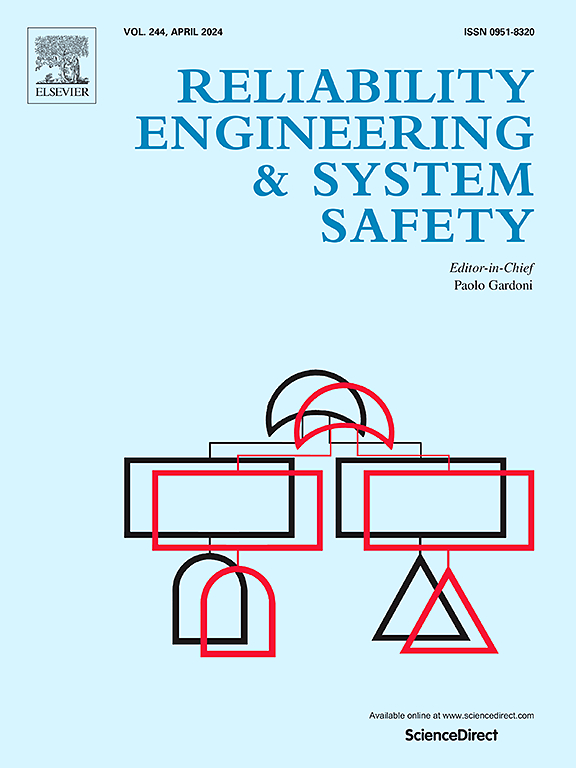Intelligent prediction model for pitting corrosion risk in pipelines using developed ResNet and feature reconstruction with interpretability analysis
IF 9.4
1区 工程技术
Q1 ENGINEERING, INDUSTRIAL
引用次数: 0
Abstract
In coastal and offshore environments, oil and gas pipelines are subjected to harsh environmental conditions, including high temperatures, humidity, and salt fog, which accelerate corrosion and deterioration. These factors significantly constrain pipeline lifespan, increase maintenance costs, and pose safety risks. Accurate prediction of corrosion rates is critical for optimizing site selection, construction, and operational strategies—forming a cornerstone of corrosion management in pipeline systems. While existing models predominantly prioritize predictive accuracy, their exploration of the relationships between influencing factors and pipeline pitting depths remains limited. To address this gap, this study introduces an enhanced residual neural network—integrating feature reconstruction—to evaluate pipeline pitting risks. Utilizing Kernel Principal Component Analysis (KPCA) and empirical formulas, the approach identifies key factors most closely correlated with pitting depths. Validation via practical engineering cases demonstrates that the proposed D-ResNet model achieves a MAE of 0.4616, MAPE of 0.3830, and RMSE of 0.5896—reducing errors by 31.6 %, 32.1 %, and 34.9 %, respectively, relative to baseline models. Furthermore, the BowTie framework incorporates SHAP (Shapley Additive exPlanations) analysis to enable interpretable risk characterization, revealing underlying mechanisms and providing a comprehensive methodological basis for lifecycle pipeline integrity management.
基于ResNet的管道点蚀风险智能预测模型及特征重构与可解释性分析
在沿海和海洋环境中,油气管道处于高温、高湿、盐雾等恶劣环境中,会加速管道的腐蚀和变质。这些因素极大地限制了管道的使用寿命,增加了维护成本,并带来了安全风险。准确预测腐蚀速率对于优化选址、施工和操作策略至关重要,是管道系统腐蚀管理的基石。虽然现有模型主要优先考虑预测精度,但它们对影响因素与管道点蚀深度之间关系的探索仍然有限。为了解决这一问题,本研究引入了一种增强的残差神经网络-集成特征重建-来评估管道点蚀风险。该方法利用核主成分分析(KPCA)和经验公式,确定了与点蚀深度最密切相关的关键因素。通过实际工程案例验证,D-ResNet模型的MAE为0.4616,MAPE为0.3830,RMSE为0.5896,与基线模型相比,误差分别降低了31.6%、32.1%和34.9%。此外,BowTie框架还结合了SHAP (Shapley Additive explanation)分析,可以实现可解释的风险特征,揭示潜在机制,并为全生命周期管道完整性管理提供全面的方法基础。
本文章由计算机程序翻译,如有差异,请以英文原文为准。
求助全文
约1分钟内获得全文
求助全文
来源期刊

Reliability Engineering & System Safety
管理科学-工程:工业
CiteScore
15.20
自引率
39.50%
发文量
621
审稿时长
67 days
期刊介绍:
Elsevier publishes Reliability Engineering & System Safety in association with the European Safety and Reliability Association and the Safety Engineering and Risk Analysis Division. The international journal is devoted to developing and applying methods to enhance the safety and reliability of complex technological systems, like nuclear power plants, chemical plants, hazardous waste facilities, space systems, offshore and maritime systems, transportation systems, constructed infrastructure, and manufacturing plants. The journal normally publishes only articles that involve the analysis of substantive problems related to the reliability of complex systems or present techniques and/or theoretical results that have a discernable relationship to the solution of such problems. An important aim is to balance academic material and practical applications.
 求助内容:
求助内容: 应助结果提醒方式:
应助结果提醒方式:


